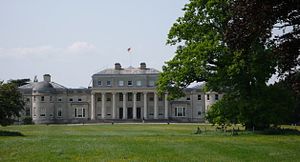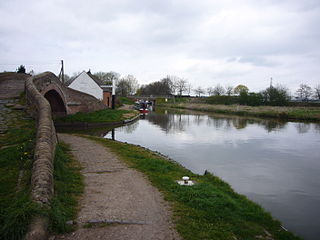
Thomas Patrick John Anson, 5th Earl of Lichfield, was an English photographer from the Anson family. He inherited the Earldom of Lichfield in 1960 from his paternal grandfather. In his professional practice he was known as Patrick Lichfield.

Earl of Lichfield is a title that has been created three times, twice in the Peerage of England and once in the Peerage of the United Kingdom (1831). The third creation is extant and is held by a member of the Anson family.
Milford is a village in the county of Staffordshire, England. It lies at the edge of Cannock Chase, on the A513 road between Stafford and Rugeley. Just to the north of the village is the River Sow.

Tixall is a small village and civil parish in the Stafford district, in the English county of Staffordshire lying on the western side of the Trent valley between Rugeley and Stone, Staffordshire and roughly 4 miles east of Stafford. The population of the civil parish taken at the 2011 census was 239.

Thomas Anson, 1st Viscount Anson was a British politician and peer from the Anson family.

Thomas William Anson, 1st Earl of Lichfield PC, previously known as The Viscount Anson from 1818 to 1831, was a British Whig politician from the Anson family. He served under Lord Grey and Lord Melbourne as Master of the Buckhounds between 1830 and 1834 and under Melbourne Postmaster General between 1835 and 1841. His gambling and lavish entertaining got him heavily into debt and he was forced to sell off the entire contents of his Shugborough Hall estate.
Thomas George Anson, 2nd Earl of Lichfield, known as Viscount Anson from 1831 to 1854, was a British politician from the Anson family.

George Anson, known as George Adams until 1773, was a Staffordshire landowner from the Anson family and a British Whig politician who sat in the House of Commons between 1761 and 1769.

Thomas Anson, FRS was a British Member of Parliament, traveller and amateur architect from the Anson family.
Colwich is a civil parish and village in Staffordshire, England. It is situated off the A51 road, about 3 miles (5 km) north-west of Rugeley and 7 miles (11 km) south-east of Stafford. It lies principally on the north-east bank of the River Trent, near Wolseley Bridge and just north of The Chase. The parish comprises about 2,862 hectares (28.62 km2) of land in the villages and hamlets of Colwich, Great Haywood, Little Haywood, Moreton, Bishton and Wolseley Bridge.
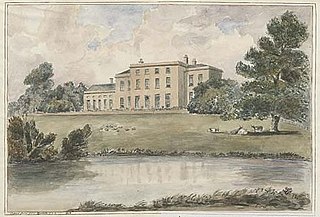
Milford Hall is a privately owned 18th-century English country house at Milford, near Stafford. It is the family seat of the Levett Haszard family and is a Grade II listed building.
The Shugborough Inscription is a sequence of letters – O U O S V A V V, between the letters D M on a lower plane – carved on the 18th-century Shepherd's Monument in the grounds of Shugborough Hall in Staffordshire, England, below a mirror image of Nicolas Poussin's painting the Shepherds of Arcadia. It has never been satisfactorily explained, and has been called one of the world's top uncracked ciphertexts.

Abbey House is an early 19th-century ruined stately home in Ranton, Staffordshire, England.
Staffordshire County Museum is housed in the Servants' Quarters of Shugborough Hall, Milford, near Stafford, Staffordshire, England. The museum features a restored Victorian kitchen, laundry and brewhouse as well as permanent galleries and temporary exhibitions.
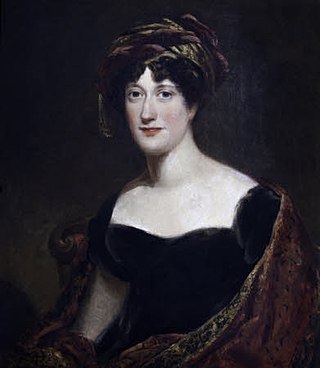
Anne Margaret Coke, Viscountess Anson, was an English painter, the daughter of Thomas Coke, 1st Earl of Leicester of Holkham, and wife of Thomas Anson, 1st Viscount Anson.

The Anson family is a British aristocratic family. Over time, several members of the Anson family were made knights, baronets and peers. Hereditary titles held by the Anson family include the earldom of Lichfield and the Anson baronetcy. Over time, several members of the family have risen to prominence, including Admiral of the Fleet George Anson, 1st Baron Anson, PC, FRS (1697–1762) and the society photographer Patrick Anson, 5th Earl of Lichfield (1939–2005).
Colwich is a civil parish in the Borough of Stafford, Staffordshire, England. It contains 73 listed buildings that are recorded in the National Heritage List for England. Of these, seven are listed at Grade I, the highest of the three grades, ten are at Grade II*, the middle grade, and the others are at Grade II, the lowest grade. The parish includes the villages of Colwich, Great Haywood, and Little Haywood, and the surrounding area. The most important building in the parish is Shugborough Hall, a large country house, which is listed together with associated structures and buildings in the grounds. The Trent and Mersey Canal passes through the parish, and joins the Staffordshire and Worcestershire Canal at Haywood Junction, and buildings associated with these canals include bridges, locks, mileposts, and a canal cottage and privy. The other listed buildings include churches, houses and associated structures, farmhouses, farm buildings, a public house, road and railway bridges, and a school.
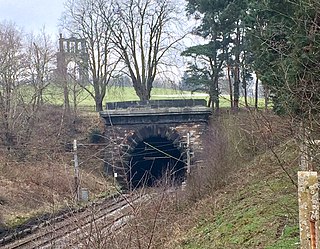
The Shugborough Tunnel is a 777-yard (710 m) railway tunnel on the Trent Valley line running under part of the Shugborough Estate in Colwich, Staffordshire, England. It was constructed in 1846 by the Trent Valley Railway and is located between Stafford station and Colwich Junction. Both portals, which were designed by John Livock, are grade II listed.

The Garden bridge in the grounds of Shugborough Hall is a cast-iron footbridge in Staffordshire, England. Dated to around 1800, It is notable as an example of chinoiserie and complements a Chinese House which is believed to be somewhat earlier.
